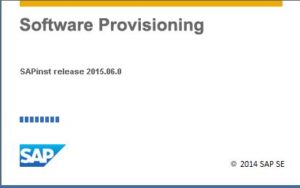 Welcome to the Part 3 of my ‘SAP ECC 6.0 IDES Server’ series in which we are undertaking the effort of setting up our own personal SAP ECC 6.0 IDES server. In this installment, we will tackle the Oracle and SAP installation and cover some post-installation activities.
Welcome to the Part 3 of my ‘SAP ECC 6.0 IDES Server’ series in which we are undertaking the effort of setting up our own personal SAP ECC 6.0 IDES server. In this installment, we will tackle the Oracle and SAP installation and cover some post-installation activities.
So far, we procured the required software and completed the configuration of our VM and the installation and setup of prerequisites. We’re now ready to start installing the two main components of our server: Oracle and SAP. If you’re just joining this series, I suggest you go back and review the preceding articles (Part 1, and Part 2) to get caught up.
STEP 16: INSTALL ORACLE 12.1
Now that our VM is configured, it’s time to put some meat on the bones. If you check out the packages you downloaded from SAP, you’ll notice that it calls for ORACLE 11.2 RDBMS. However, I ran into some compatibility messages when doing the SAP install. I ultimately decide to use ORACLE 12.1 (a.k.a. ’12c’) for this installation.
I’m not going to cover each single step in detail:
-

Oracle 12.1: Database Only Locate your Oracle install files. As noted in Part 1, I had issues when I attempted to use Oracle 11g. So instead I opted to use Oracle 12.1 (database and client), also available from SAP’s site. After extracting the package (package 51047709), you can find the installer inside the ‘database’ sub-folder. Execute ‘setup.exe’.
-
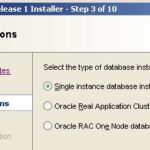
Oracle 12.1: Single Instance I opted to leave the email address blank and uncheck the “I wish to receive security updates…” checkbox. It will question your decision; just stay strong and remain uniformed. 😉 Click ‘Next’ and ‘Yes’.
- Skip the updates, if prompted.
- Select the ‘Install database software only’ option (the SAP installer will create the database). Next.
- Select the ‘Single Instance database installation’ option. Next.
- Add any additional languages; I’m sticking with English. Next.
- Select the ‘Enterprise Edition’ option. Next.
- Select the ‘Use Windows Built-in Account’ option for the “Oracle Home User Selection” screen. Next. It will recommend using a separate user ID with limited privileges; just select “Yes” to continue.
-

Oracle 12.1: Home User Selection For the installation paths, I left the values defaulted. Just make sure they are pointing to your ‘SAPDATA’ drive, in my case it’s “D:\”. Next.
- It will then do a prerequisite check. No action needed.
- On the Summary screen, verify the parameters you selected and click ‘Install’.
- The installation took about 15 min.
- Restart the VM when the installation is complete.
STEP 17: CHANGE ORACLE “COMPATIBLE” PARAMETER
I had run into an issue later on in the process: The Software Provisioning Manager (SWPM 1.0) prompted me that Oracle client 11.2 was not acceptable; it was looking for 12.1. However, when I installed client 12.1 I received an error during Database creation indicating that the Oracle ‘Compatible’ parameter was not valid. Reviewing this page, I reviewed the ‘INIT.ORA’ file. [NOTE: I also read through notes 1431798, and 1739274 which both deal with Oracle Parameters.]
In Windows Explorer, navigate to the the ‘dbs’ folder to locate your init.ora file. Mine was located here:
D:\app\[USER ID]\product\12.1.0\dbhome_1\dbs
Edit the file using Notepad and find the existing ‘compatible’ parameter. Mine looked like this:
compatible ='11.2.0'
…and based on the SAP Note, I changed it to this:
compatible ='12.1.0.2'
Save the file.
STEP 18: INSTALL SAP ECC 6.0 IDES
SAP Installation will begin by launching the install process from within the SWPM. When you launch this process, a host of options will be presented; each option will include an installation wizard to guide you along the way. While I tried to include as many screenshots as possible, I did omit several steps where I simply chose the default settings proposed by the wizard. There will be two phases to the install: a prerequisites check followed by the real installation.
Check Prerequisites
The first thing I did was run the pre-requisites check. This process will perform some hardware and software checks to make sure that the installation can take place successfully. Following the process I outlined in this series, I never received anything but “OK” messages for each section.
-
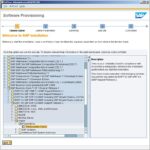
SAP Prerequisite Path Launch the SWPM using the “sapinst” executable.
- Navigate to:
SAP Business Suite 7i 2013 Support Release 2 –>
EHP7 for SAP ERP 6.0 ABAP Support Release 2 –>
Oracle –>
Preparations –>
Prerequisites Check -
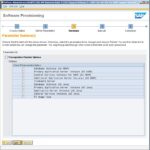
SAP Prequisite: Options. Hit ‘Next’ twice to accept the defaults for the checking parameters. Leaving all the checkboxes empty will only check the critical elements.
- You will see a 2-phase process start to run. It won’t take long — maybe 3 or 4 minutes.
- You will eventually be presented with a table containing the various elements of the prerequisites check. If everything

SAP Prerequisite: Results looks good, you should see an “OK” in the ‘Result Code’ column for each item. Click Next.
- You will also see a message box pop up indicating that the check has been completed and suggesting that you resolve any checks which may have failed.
- Clicking the “OK” button will close out the Software Provisioning Manager. I’m
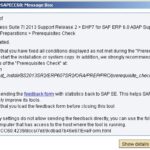
SAP Prerequisite: Completion Message not sure why this is the case, because we’re just going to hop back in there for the real installation.
Assuming that everything went ‘OK’, then we can now start the full installation of SAP. If everything did NOT go ‘OK’, then you’ll need to do some legwork to find out what the resolution should be.
SAP Full Installation
Here we go! There are a lot of steps in this process; however, don’t get intimidated. Most of the options below will just involve selecting the default values.
-
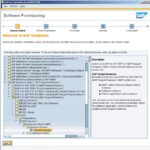
SAP Full Installation Option As you did before, launch the Software Provisioning Manager using the “sapinst” executable.
- This time, navigate here:
SAP Business Suite 7i 2013 Support Release 2 –>
EHP7 for SAP ERP 6.0 ABAP Support Release 2 –>
Oracle –>
SAP Systems –>
Application Server ABAP –>
Standard System –>
Standard System
…and click ‘Next’. -

SAP Full Instatllation: Typical or Custom? Parameter Settings:
On the Parameter Settings, you must select either ‘Typical’ or ‘Custom’. I’ve tried it successfully using both methods. I chose Custom for this install in order to show all the options. Next. You will be prompted that the system needs to log you off in order to continue. Click ‘yes’ and the account is logged off and back in automatically. -
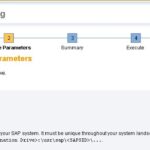
SAP Full Install – System ID General SAP System Parameters:
Choose your SAP system name. This is the 3-digit alphanumeric code which identifies your SAP system. I’m not sure what the restrictions are, but I would use something unique. I’m using “ROM” for mine. Also choose your destination drive; again, for me this is “D:”. Next. - DNS Domain Name:
Uncheck the “Set FQDN for SAP system”. Next. -
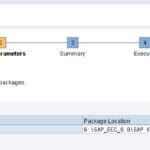
SAP Full Install: 7.42 UC Kernel Media Browser – UC Kernel NW740 SR2:
You’re going to face at least three “Media Browser” screens in which you will need to select one of your installation packages using the ‘Browse’ button. For the UC Kernel (UC = Unicode), navigate to the “SAP Kernel 7.42 Windows Server on x64 64bit” folder (package # 51049350). Make sure you select the package folder which contains the DATA_UNITS folder and click “OK”. Next. -
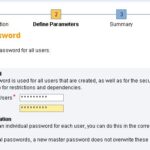
SAP Full Install – Master Password Master Password:
This password is used as the default for all user accounts created during the installation process. You will have the option to replace the passwords for individual accounts if you want to, but this one will be used as the default. Just make sure you remember it.
NOTE: Avoid using a master password containing the “@” symbol. Readers have reported that this causes errors downstream. [Thanks, raghaf2007] - Windows Domain:
Just stick with the ‘Local Domain’ option, unless you know what you’re doing. Next. - Operating System Users:
Just click ‘Next’ to accept the default password you setup earlier. -
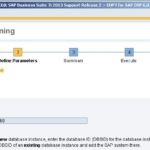
SAP Full Install – SAP System Database ID SAP System Database:
Choose your database ID. This is another three-character identifier. I just chose ‘EC6’ as mine. Next. - Windows Domain for SAP Host Agent:
Again, just choose the ‘Local Domain’ option. Next. - Operating System Users:
This sets up the password for the sapadm account. Just keep your default password. Next. -
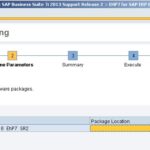
SAP Full Install – Export 1 Media Browser – Installation Export 1 ECC 6.0 EhP7 SR2
Like the previous ‘Media Browser’ selection, click the Browse button and navigate to your “IDES SAP ERP 6.0 EHP7 Inst. Export” folder. Choose the first package (package # 51048312_1) and click “OK”. NOTE: Don’t select the individual Export folders located inside the
SAP Full Install – Select Package DATA_UNITS folder.
- Media Browser – Installation Export 2 ECC 6.0 EhP7 SR2
Like the previous step, navigate to find the second package in the “IDES SAP ERP 6.0…” folder (package # 51048312_2). Select it, click “OK”. Next. - Oracle Database Destination:
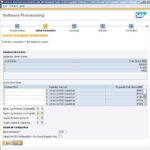
SAP Full Install – Oracle DB Destination I just made sure that everything is pointing to the same “D:” drive — even the Log Archives on the bottom of the window. Next.
- Oracle Database:
Just accept the defaults. Next. - Oracle Database Accounts:
Accept the default passwords, but use the ‘Use Windows built-in Account’ option. Next. -
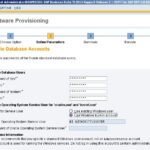
SAP Full Install – Oracle DB Accounts, Windows Built-in option Oracle Listener Configuration:
Just accept the defaults. Next. - Declustering / Depooling Option:
Select the ‘Do not decluster…’ option. Next. - SAP System Database Import:
I changed the Number of Parallel jobs from ‘3’ to ‘4’; I have four cores on my CPU and SAP recommends 2 to 3 per processor. This controls the number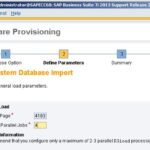
SAP Full Install – Parallel Jobs Selection of ABAP Import objects which can be processed at once. Having ‘4’ worked for me; you may wish to keep yours at ‘3’. I don’t think it will be a big impact either way. Next.
- Create Database Statistics:
Accept the defaults. Next. - Primary Application Server Instance and ABAP Central Services Instance:
Accept the defaults. Next. - ABAP Message Server Ports and Transport Host:
Accept the defaults. Next. - ICM User Management:
Accept the default password. Next. - SLD Destination for the SAP System OS Level:
Accept the default ‘No SLD destination’ value. Next. -
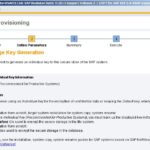
SAP Full Install – Default Key Selection Message Server Access Control List:
Accept the default ‘Do not create message server…’ value. Next. - Secure Storage Key Generation:
Select the ‘Default Key’ option since additional security is probably not required. Next. - Media Browser – Oracle Client 121:
Click the Browse button. From within the Oracle 12.1 Client package (package
SAP Full Install – Oracle Client 12.1 # 51049088), select the folder which corresponds to your OS — mine is OCL_WINDOWS__X86_64 — and click ‘OK’. Next.
- Unpack Archives:
Leave everything checked. Next. - Install Diagnostics Agent:
Can leave this unchecked since I won’t be using Solution Manager. Next. - Parameter Summary:
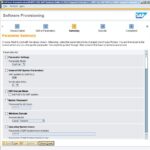
SAP Full Install – Pre-installation Summary This is your last chance to change parameters before installation. It is a good idea to review this list to make sure it makes sense. Check that the destination drives mentioned are the ones you want. Next.
- Task Progress:
The installation will begin. You’ll be presented with a ‘Task Progress’ screen which will help you track the progress of the installation. You should have 37 tasks (or Phases) included. Check in on the installation periodically to see how it’s progressing. This will probably take anywhere from 6 to 12 hours depending on the speed of your system.
NOTE: Towards the end, you may receive a warning indicating that the “Test logon to SAP system [SID] failed” for user DDIC. Don’t panic. This should be fine; the DDIC password should be the one that you setup previously.
ANOTHER NOTE: Frequently, I have had an error occur during the ‘Import ABAP’ phase. One or two of the objects error-out with error 103 (no additional info is given). Using the ‘Retry’ option, I have been able to re-run the errant processes successfully.
-
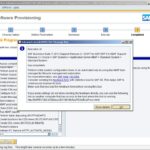
SAP Full Install – Success! The process will complete and you should see a pop-up Message Box indicating everything is completed. Click ‘OK’.
- A ‘Log Analyzer’ pop-up will appear next showing you where you can find the installation logs. Close this window and you’re done.
If issues do pop up…
…you should have the option to perform a “Retry” function in which case SAP will attempt to re-perform the operation. I’ve tried this with mixed results — sometimes the installation completes successfully, and other times it continued to give me the same error. Apart from “Retry”, you also have the “Stop” option in which case you abort the installation. In theory, assuming you can correct whatever the main issue is, you should be able to pick up the installation where you left off. When you re-start the installation from the Software Provisioning Manager, it will find your previous installation attempt and present you with the option to continue with the “existing option” or create a “new option”. I recommend that you start from scratch with a new installation. Every time I attempted to use the “existing option” I always ended up with other issues down the road.
STEP 19: VERIFY YOUR ECC 6.0 IDES SERVER IS RUNNING
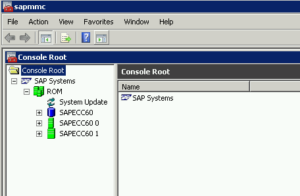
You should find an ‘SAP Management Console’ link on your desktop. Double click this to launch the console. Once inside, you’ll see a console tree which you can expand to see a more detailed status of your system. The screenshot to the right is what you SHOULD see for your system. The first green icon should be next to your System ID — ‘ROM’, in my case. That should be followed by two other green icons which may represent different instances or clients (not sure). At any rate, if yours looks like the screenshot, you should be in good shape.
STEP 20: INSTALL SAP GUI
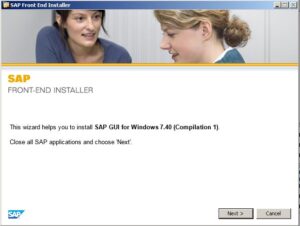
You want to use your new server, right? Then, you’ll need to install your SAP GUI. Luckily, you can find the latest SAP GUI version included in the “Presentation – 7.40 Compilation 1 Presentation 1” package (Package # 50127120_6). From within the package, execute the SapGuiSetup application located in the following path:
...\Presentation - 7.40 Compilation 1 Presentation 1\PRES1\gui\windows\win32\
Just follow the wizard to complete the installation. Select the “SAP GUI for Windows 7.40 (Compilation 1)” checkbox, and click “Next” and then “Next” again to get started.
Once installed, go ahead and start SAP GUI with the desktop icon. You’ll need to add your new server:
- Click the icon that looks like a blank sheet of paper.
- Click “Next”.
- Input your new connection’s parameters (see mine below) and click ‘Finish’.
Description SAP ECC 6.0 IDES, EhP7 Application Server 192.168.25.25 Instance Number 00 System ID ROM
That should do it.
STEP 21: FIRST SAP ECC 6.0 IDES LOGON
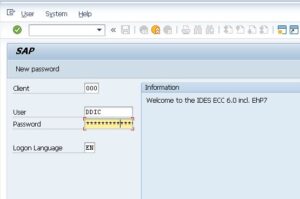
Here we are: The moment of truth. Fire up your new SAP connection from SAP GUI. For my first logon, I used the standard SAP user id DDIC. You should be able to use the default master password you chose during the installation.
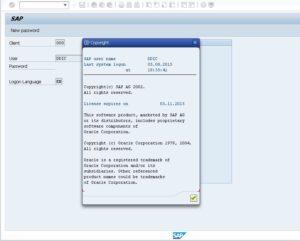
What do you do from here? I would probably create a separate user ID for your normal day-to-day usage. I would perhaps copy the SAP* user id to a new one. Apart from that, you should be able to start using the system normally. If you wish to avoid the constant “compiling” which you will see, you can attempt to run
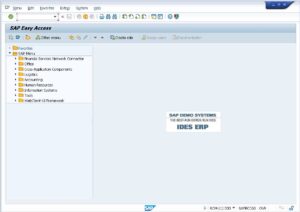
SGEN to generate all those objects. I may create a separate guide for doing so later on (or I may not, don’t hold your breath).
IMPORTANT NOTE: While creating my own user ID in my new SAP system, I encountered an error:
Category ABAP Programming Error Runtime Errors GETWA_NOT_ASSIGNED ABAP Program SAPLCRFC Application Component BC-MID-RFC
The root cause of this error (at least, in my case) was that the RFC destination was not setup for the Transport Management System (TMS). Additional information is included in the following SAP Note: 2051222 – Dump GETWA_NOT_ASSIGNED RFC_READ_R3_DESTINATION. Following instructions on this SAP help page resolved the issue.
STEP 22: TAKE A SNAPSHOT
We’ve come a long way and there are too many ways to screw up an SAP This is the third installment of my SAP ECC 6.0 IDES series in which I walk through how to download, install, and run your very own ECC 6.0 IDES server. installation. It may be a good time to take a VirtualBox Snapshot to preserve the system state in case we need to trudge back to this point.
CONCLUSION
There you have it: You’ve just logged on to a fully-functional SAP ECC 6.0 IDES system running on your very own hardware. Congratulations! With any luck, you’ve endured a lot fewer re-starts than I have. I’m too embarrassed to admit the number of times I had to restart this whole process.
I don’t know about you, but I now have a lot more respect for all those Basis consultants out there who deal with this type of stuff (and much more) day-in and day-out. Of course, there’s a lot more to this in the real world. If this guide helped you, please let me know in the comments. Likewise, if you’re stuck I will try to offer what meager assistance I can. Best of luck to you!
…but, wait… There’s more! Stay tuned for a bonus article where I tackle some additional topics to consider and help you along your way to running SAP ECC 6.0 IDES.










Michael! Thanks to your guide I successfully installed SAP IDES!
Is it possible to use transaction “SAINT” in order to install Add-ons?
I’d like to use Fiori Apps on it.
Grazie mille!
Andrea,
Thank you very much for taking the time to comment; yours is the first confirmation I have received that my guide is — at least somewhat — accurate.
Yes! I have been able to apply patches using SAINT. My goal is to also be able to use Fiori apps as well as Screen Personas. However, Basis is not my forte. If you get Fiori apps working, I would appreciate some comments on steps you took to get it working.
Also, you may want to make sure you have a viable license setup lest you put all this work into your SAP system and are limited in how you can use it.
Thanks again,
Michael
Michael,
I think that if you’ll decide to write another post called “SAP IDES first steps” it would be most clicked in the web (other guide are obsolete or not useful).
I mean only to describe:
– how to apply the license
– how to set TMS
– how generate ABAP load with SGEN
– and maybe how to set the profile parameter with RZ10
Unfortunately I’m still a newbe to do something like that.
Ciao ciao!
Andrea from Italy
Hi Micheal
I am struggling to get SAP IDES file for installations,i dont have any contact with SAP guys ,i am an oracle DBA and currently preparing for SAP Basis administration,can you provide me any link to get all those files i will be more than grateful to you
Sorry you’re struggling. I’m afraid I can’t help with the files. The only legal way is through SAP which requires an S number. You can ask your employer for one or get one through a certification. – Michael
can you tell me until when SAP IDES 6 is supported by SAP
I don’t know, Frans. There is a limited time line for R/3 systems. R/4 will be rapidly upon us soon. I can’t say when the R/3 platforms will no longer be supported.
Hi Michael,
I’ve tried to install SAP IDES EHP7.
But i get a completely different sequence during my installation procedere.
I get point 5: DNS Domain Name
but not point 6: Media Browser – UC Kernel NW740 SR2
Instead of that i get something where I have to put in the path for:
SAPEXE.SAR 7.42
SAPHOSTAGENT.SAR 721
IGSEXE.SAR
IGSHELPER.SAR
SAPEXEDB.SAR
When I put in the path – he says all that files are available.
When I go forward – I get an Error
(…. not all files Could be extracted …. )
Could you imagine what is wrong here?
regards
Manfred
First, this process is going to vary from version to version, but the general process should be similar. If you want to use this guide, please make sure the files and installers are consistent with what I specified. I’m sure I will get around to updating this guide at some point, but probably not for a while. Best of luck!
Hi Michael,
is this installation a pure netweaver + business suite or does it really contain the IDES data?
is there any issues with licences (developer keys) etc. when used in a private environment?
would be really nice if SAP would provide a fully functional IDES VM to download but I guess that won’t happen
This installation includes the NetWeaver platform and the full IDES data set. The installation contains the default license period — 90 days maybe? You would have to request a license extension from SAP from their support Portal. I wrote a few details about it in the Appendix section. I hear that there are tools to generate developer keys and object keys if needed. Good luck!
Hello Michael, I am about installing the SAP IDES.
1. I search the SAP Marketplace. Oracle is no longer available as a DBMS. I have opted for MSSQL Server. I hope the installation process remains the same.
2. I intend installing on XEON Server as a host, where I can connect about 2 systems to. Any difference in configuration?
Hello Michael! good stuff. I was looking to show a friend what to do to have his own R3 sandbox to play and get trained in SAP. I have many years of Basis experience on my back. I really appreciate the time you took and the initiative to put all this info available for everybody. I would like to help you with the implementation of Fiori and screen Personas. Have you already started? what trouble do you have? please feel free to drop me an email and I will guide you in the journey to the new SAP User Experience (Fiori)
Best Regards,
.-Ruben
Ruben, thanks so much for your comment and your offer of assistance. I haven’t had much time to dedicate to this topic recently, but when I do, I will reach out to you for some guidance. Thanks again. -Michael
Hi Michael during installation of SAP phase 22 of 37
I got this error could you please give me a hand
I have zero knowledge of SAP but I really will like to learn
An error occurred while processing option
SAP Business Suite 7i 2013 Support Release 2 >
EHP7 for SAP ERP 6.0 ABAP Support Release 2 >
Oracle > SAP Systems > Application Server ABAP >
Standard System >
Standard System( Last error reported by the step: Process call ‘F:\usr\sap\ROM\SYS\exe\uc\NTAMD64\brconnect.exe -u / -c -f chpass -o SAPSR3 -p XXXXXX’ exits with error code 5. For details see log file(s) brconnect.log.). You can now:
What does the log say?
Hi could this be the log file you are asking me for?
TRACE 2017-07-13 19:36:05.840 (SAPECC60\Administrator) [syxxclogbook.cpp:215] PSyLogBook::initSAPKernelTracing(int traceLevel, const CSyPath & filePath)
Initialized SAP kernel tracing to file dev_sap_kernel
TRACE 2017-07-13 19:36:05.840 (SAPECC60\Administrator) [synxcuser.cpp:2106] CSyUserImpl::isExistingOnOS()
existence check for user Administrator returned true.
TRACE 2017-07-13 19:36:05.840 (SAPECC60\Administrator) [syxxccache.cpp:419] CSyAccountCache::addToCache(const IaPtr account)
inserted account (Administrator, S-1-5-21-125649288-1730276325-2172517612-500, USER) into the accountcache.
TRACE 2017-07-13 19:36:05.840 (SAPECC60\Administrator) [csimanagerinterfaces.cpp:2959] CSiComponentSet::getExePath()
exe dir is C:\Users\ADMINI~1\AppData\Local\Temp\sapinst_exe.2512.1499999578
TRACE 2017-07-13 19:36:05.840 (SAPECC60\Administrator) [csimanagerinterfaces.cpp:2350]
MessageLib initialized successfully.
INFO 2017-07-13 19:36:05.840 (SAPECC60\Administrator) [synxcpath.cpp:799] id=syslib.filesystem.creatingFile CSyPath::createFile()
Creating file C:\Users\Administrator\AppData\Local\Temp\sapinst_exe.2512.1499999578\dev_sap_kernel_test_13_Jul_2017_19_33_41.
INFO 2017-07-13 19:36:05.840 (SAPECC60\Administrator) [synxcfile.cpp:376] id=syslib.filesystem.removedFile CSyFileImpl::removeEx(ISyFSErrorHandler * pErrorHandler)
Removed file C:\Users\Administrator\AppData\Local\Temp\sapinst_exe.2512.1499999578\dev_sap_kernel_test_13_Jul_2017_19_33_41.
I just found brconnect.txt
BR0801I BRCONNECT 7.40 (12)
BR0280I BRCONNECT time stamp: 2017-07-13 19:38:43
BR0828I Changing password for database user SAPSR3 …
BR1628E Invalid character ‘@’ in database password
BR0832E Changing password for user SAPSR3 failed
BR0280I BRCONNECT time stamp: 2017-07-13 19:38:43
BR0804I BRCONNECT terminated with errors
Hi I have finished installed successfully it was so easy but got lost in so many lines I just retyped a new password with out this character
BR1628E Invalid character ‘@’ in database password
thanks for your tutorial
I’m so glad this worked for you. Troubleshooting those errors is tedious. Thanks for posting.
Hi Michael I finished installing SAPGUI and logon successfully so I decided
to shut down close logoff SAPGUI close SAP and shut down the virtual machine
but this message showed up :
Micrsofot Management Console
This snap-in console file (C:\Windows\spammc.msc) was saved with
an earlier version of Microsoft Management Console (MMC). Do you want to
update it to MMC version 3.0 format?
To update and close the file. click Yes. You will no longer be able to use the file with earlier versions of MMC.
To discard changes and close the file, click No
To return to the file, click Cancel
[Yes] [No] [Cancel]
I chose buttons [No] and/or [Cancel]
and when I start the virtual machine
and start SAP the SAPECC60 0 icon is yellow and only SAPECC60 1 is green and can not logon with SAPGUI
(STEP 19: VERIFY YOUR SERVER IS RUNNING this icons should be green)
please help
Are you using Oracle for your DB? I believe you need to make sure your ‘Oracle Listener’ is running. You should be able to find it in the VM’s ‘Services’ app. I can’t remember the exact name, but I think it’s just ‘Oracle Listener’.
Hi Michael how can I renewal the license? it shows it will expire on
04/10/2017
Please read the next part of my series where I address your question. -Michael
All the info you provided are very helpful. Thanks for your help. I successfully installed SAP ECC 6.0 EHP7 IDES. The issue that I encountered is during “Checking whether the server is running”. My system ID is in “green” status. SAPECC6 1 is also in “green” status. But the SAPECC6 0 is in “yellow” status. Any idea how to fix this or if this is causing the error I get when I tried to login to SAP GUI? Your help will be very much appreciated. 😀
Kevin, not sure if I replied to this. Please make sure your Oracle Listener service is started prior to launching SAP.
regards
I have a serious problem, because in the installation during the IMPORT ABAP process I get this_
” Import Monitor jobs: running 1, waiting 0, completed 163, failed 0, total 164.”
And does not progress or simply disappears the installation tracking screen and does not run.
I have restarted the installation of SAp several times.
I hope your help and collaboration
Williams,
I don’t have any great advice for you other than to see which job is getting hung and googling for a solution.
Hi, thanks for all information, i have this error in step 22
http://www.forosdelweb.com/f57/configuracion-xampp-para-acceso-externo-980360/
Can you help me please?
Error message: ORA-01078: failure in processing system parameters LRM-00109: could not open parameter file ‘C:\APP\ADMINISTRATOR\VIRTUAL\PRODUCT\12.2.0\DBHOME_1\DATABASE\INITEDB.ORA’ Disconnected . SOLUTION: For more information, see ora_sql_results.log and the Oracle documentation.).
Ignacio, Thank you for your comment. Unfortunately, I don’t know how to resolve your issue. What I’ve found is that the details are buried in the log files. Google is your friend. Good luck!
Hello Michael, I have followed your instructions but I am receiving this error saying that DDIM.SQL & DODS.SQL are not found (this is also posted here in the link https://answers.sap.com/questions/352555/sap-ides-ecc-60-ehp7-oracle-installation-error-ddi.html). I have searched google throughly and also some sap notes (but I do not have access currently to Marketplace). Do you have any suggestions on this error?
I have downloaded the Installation Export from some external source and it is a standard that every folder ..\ORA\DB\* has not those files, but just DFACT.SQL.
If you please could help it would be very nice!
Thank you,
Hey Michael, how are you been?
I am installing sap ecc 6.0 ehp7 ides following the step by step, but my version is new (web). I am in step 13 and I have the error:
Data unit \\ vboxsrv \ Sap \ 51050166_Data \ 51050166_1 \ DATA_UNITS \ EXPORT_1 is not signed.
DETAILS: The data unit should not be used.
SOLUTION: Ensure that you use the latest version of Installation Export 1 ECC 6.0 EhP7 SR2 downloaded from the SAP Service Marketplace and ensure that its content is unchanged.
Thanks
To solve the problem EXPORT_1 is not signed, its necessary open a Sap Incidente asking for a file signature.
https://answers.sap.com/questions/452047/data-unit-csap-downloads51050166-1data-unitsexport.html
Now, i’m in step 28 – Media Browser – Oracle Client 121:
The error is: ‘ solution: Specify the location which contains the correct LABEL.ASC file (look for ORACLE:11.2:CLIENT:*:WINDOWS_X86_64:*). ‘
But my Oracle version is 12.1
Hi Michael,
my SAP it´s completelly working, but, when I tried to follow a tutorial step to do something, the system advise me something about “custom user can not do …. ” I tried with the differents users you provide on the appendix but its the same, what I need to do.
Thanks for your comment, Franck, but I’m afraid that you haven’t provided enough information. All I can tell from your note is that you were trying to do something and a message said that you can’t do that thing. -Michael
Hi Michael,
It is a very detailed walkthrough.
As of now, I check on the Software Downloads, there is no IDES package to be installed on Oracle DB. There are only 3 databases available for download, MaxDB, SAP ASE, and SAP HANA.
So how could I get the instance which can be installed on Oracle?
Hello and thanks for commenting. I just confirmed that when I access the path mentioned in Part 1 of my series, I do still have the ability to filter results by “Microsoft Windows” and then “Oracle Database”. I am seeing this for EHP7 and EHP8. Please note that the options to filter have been moved to two Combo Boxes above the list of downloads. Hope this helps.
Michael good afternoon !
I had the following error:
DIAGNOSIS: Error message: ORA-00401: the value for parameter compatible is not supported by this release Offline. SOLUTION: For more information, see ora_sql_results.log and the Oracle documentation.).
I commented that I made the change of parameter in the ini.ora file by 2 values:
1.- Path: G: \ app \ Administrator \ product \ 12.1.0 \ dbhome_1 \ dbs
1.1- compatible = ’12 .1.0.2 ‘==> indicated by your person
1.2- compatible = ’12 .1.0.1.0 ‘==> version of the oracle that instalè
… and with none worked
2.- I went to the path: C: \ Program Files \ sapinst_instdir \ BS2013SR2 \ ERP607SR2 \ ORA \ INSTALL \ STD \ ABAP and opened the file ora_sql_result, and in the log it indicates the same error of the sap installation:
QL * Plus: Release 12.1.0.1.0 Production on Wed Dec 26 15:30:46 2018
Copyright (c) 1982, 2013, Oracle. All rights reserved.
Connected to an inactive instance.
ORA-00401: the value for parameter compatible is not supported by this release
Disconnected
SAPINST: End of output of SQL executing program G: \ app \ Administrator \ product \ 12.1.0 \ dbhome_1 / bin / sqlplus.
SAPINST found errors.
SAPINST The current process environment may be found in sapinst_ora_environment.log.
2018-12-26, 15:30:54 SAPINST ORACLE stop logging
3.- I opened the file ‘LogAnalyzer'(PATH:C:\Program Files\sapinst_instdir\BS2013SR2\ERP607SR2\ORA\INSTALL\STD\ABAP ) and it does not deliver information associated with any parameter compatibility value
I do not know with what value to prove …
Help me with some tips please
Regards.-
Sorry for the delayed response. I wish I could be of more help. I remember that the SAP installation had very strict expectations about versions being in alignment I would make sure that you’re using the proper version of Oracle and that any necessary parameters are adjusted. You can also check out SAP notes for the specific version of Oracle that you’re installing (examples are 1431800 and 1431798). These can help guide you through how parameters are to be maintained. Good Luck!
Michael good afternoon, could you tell me exactly the version of oracle that you installed in your SAP please
Regards.-
Alvaro.
Michael … I forgot to mention that the manual is very complete, as well as many thanks for the time dedicated and for sharing with those we want to learn.
Receive a cordial greeting =)
Thank you for this note. I can’t believe that this experiment of mine was three years ago! I’m not sure I have the stomach to make an updated version. Thanks again and good luck!
Hello Michel. First thank you for this great contribution. I have installed SAP without problems, but when verifying the server in the console, the tree (ROM) does not appear. I have listened to Oracle, I have reinstalled it and the problem persists. I know that years ago of this contribution, I would appreciate any help.
Jud, thanks for commenting. Unfortunately, I have never run into this situation. I would try googling that to see what you find. I did a quick search and found this discussion. Sorry. Good luck! Please post back once you have found your solution.
I guess there was a problem during installation. I reinstalled SAP and I found a problem in Import ABAP (2 failed files), solve it following the instructions of: http://www.snatic.com/2015/07/06/sapbasis-como-reparar-errores- in-the-process-of-abap-when-they-fail-the-installation /. And I reinstalled SAP for the third time. Now everything is perfect. Thank you very much again for the contribution Michel
That’s great news, Jud. Thank you so much for sharing your solution.
im very thankful for your guide. 10/10 guide.
i installed mine in windows server2012r2…. got into the “@” character in the oracle database password issue… re installed the whole thing with a new password. (if possible try to mention it in your guide – to not use “@” character in the master password). took me for around 7 hours.
now i can practice the sap modules with out paying to a separate service which provides IDES access for wayyy more money.
THANQ very much Micheal 🙂
Thank you for the suggestion and the feedback, raghaf. I’ve appended your recommendation to the article. I’m glad you’re up and running!
Hi Michael, hoping you are well, I need to know if in this EHP7 you are programming in Abap and configuring the MM Module?
I remain attentive to your comments.
Regards.-
It’s good to hear from you. This IDES implementation should be 100% functional, meaning that you should be able to adjust code and configuration as needed. I hope this addresses your question. -Michael
Hi Michael,
I have a problem, i’ve already installed everything, but when I want to stop tha sap from the sapmmc, is asking for a password, is it the same that I set for the users?
That’s a great question, Willy. Every time you take down the SAP server, it will ask you for a reason why you’re bringing the server down — for trace-ability, I suppose. I think it’s normal for the SAP Console to prompt for credentials. It’s been a while, but I believe that these will be the admin/server credentials established during your install and not an SAP User. I could be wrong. I hope this helps.
Hi, i have a little problem during the instalation, this is the log.
————————————————————————————-
TNSLSNR for 64-bit Windows: Version 10.2.0.4.0 – Production
System parameter file is C:\oracle\product\10.2.0\db_1\network\admin\listener.ora
Log messages written to C:\oracle\product\10.2.0\db_1\network\log\listener.log
Listening on: (DESCRIPTION=(ADDRESS=(PROTOCOL=ipc)(PIPENAME=\\.\pipe\EXTPROC1ipc)))
Listening on: (DESCRIPTION=(ADDRESS=(PROTOCOL=tcp)(HOST=SAPECC)(PORT=1521)))
Listening on: (DESCRIPTION=(ADDRESS=(PROTOCOL=ipc)(PIPENAME=\\.\pipe\EC6.WORLDipc)))
Listening on: (DESCRIPTION=(ADDRESS=(PROTOCOL=ipc)(PIPENAME=\\.\pipe\EC6ipc)))
Error listening on: (DESCRIPTION=(ADDRESS=(COMMUNITY=SAP.WORLD)(PROTOCOL=TCP)(HOST=SAPECC)(PORT=1521)))
TNS-12542: TNS:address already in use
TNS-12560: TNS:protocol adapter error
TNS-00512: Address already in use
64-bit Windows Error: 48: Unknown error
——————————————————————————
and another quetion is, in the step 28 – during the instalation i didnt saw this part and couldnt upload the database. it’s possible?
I’ll be honest: I have no idea how to solve this issue. I had the most success googling for the errors that I encountered to identify solutions. Perhaps someone else reading can make a suggestion.
Hola Michael espero te encuentres bien
Al termino de la instalación no me aparece en el árbol de consola los iconos, e instalé también el sap gui 740 y sale error: partner 192.168.25.25:sapdp00 not reached
I apologize, but I won’t be able to help you with this. You can probably google the error message and see what others say. Best of luck.